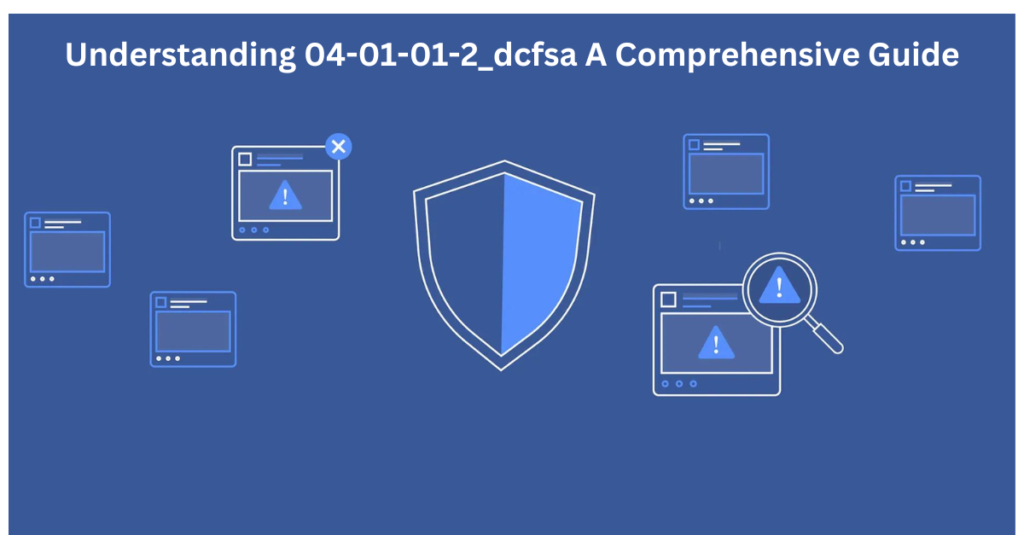In statistics management and coding, specific terminologies and codes are regularly maintained at large, which means. One such term that has gained interest is “04-01-01-2_dcfsa.” This article delves into the complexities of the term, its use of capacity, and the implications it would have in different contexts.
What is 04-01-01-2_dcfsa?
“04-01-01-2_dcfsa” appears to be a dependent alphanumeric code. To fully understand its meaning, we want to break it down into its component parts:
- 04-01-01-2: This series probably represents a categorization or class of gadgets. In many data systems, such codes are used to identify unique sections, classes, or hierarchies within a dataset.
- Dcfsa: This extension can be an abbreviation or code representing a selected statistics format, gadget or methodology.
Possible Interpretations and Applications
1. Data Classification Systems
When reviewing records, codes such as “04-01-01-2_dcfsa” are regularly used to classify and organize facts. These codes help segment information into achievable categories and ensure that facts can be successfully retrieved and analyzed. For example, in a large medical data database, any such code may imply a selected type of record or a specific record access arrangement.
2. Software Development
In software enhancement, codes of this nature may be used for model control or feature identity. For example, “04-01-01-2” should discuss a wide range of versions or bootcycles, while “dcfsa” can refer to a specific module or feature set related to that version. This systematic method helps developers change music and maintain consistency across different versions of a software program.
3. Compliance with Regulations
Some industries, especially those dealing with sensitive data, use coded structures to comply with regulations. “04-01-01-2_dcfsa” can be part of the compliance framework, support groups adhere to the requirements and protocols required by means of regulatory bodies. For example, in the financial sector, such codes can be used to categorize compliance checks or audit records.
4. Data Encryption and Security
In fact protection, codes like “04-01-01-2_dcfsa” can be used to select encrypted facts or security protocols. The extension “dcfsa” may represent a selected popular encryption or security algorithm, which means that the information is masked according to certain guidelines.
Implementation and Administration 04-01-01-2_dcfsa
1. Integration into Systems
When integrating a code like “04-01-01-2_dcfsa” directly into a device, it is important to ensure that all relevant stakeholders understand its meaning and vigilance. This can include creating documentation that explains the reason and use of the code, as well as training a team of workers to paint with it effectively.
2. Accuracy and Consistency of Data
Maintaining accuracy and consistency of information is essential when using such codes. Ensuring that code is implemented efficiently and continuously across extraordinary datasets makes it easier to avoid errors and inconsistencies. Regular audits and assessments can help identify and address any issues that arise.
3. Security Aspects
If “04-01-01-2_dcfsa” is associated with the protection of facts, the implementation of robust security measures is essential. This includes the use of encryption, obtaining the right to access controls and routine security assessments to protect sensitive information.
Potential Challenges and Solutions
1. Complexity in Understanding
One of the liabilities with codes like “04-01-01-2_dcfsa” is that they can be complex and difficult to understand without proper context. To deal with this, companies should provide clear motivations and education to make sure customers can interpret and practice the code effectively.
2. Integration with Existing Systems
Integrating new codes into existing systems can be difficult, especially if those systems were not originally designed to accommodate such codes. This may require upgrades or changes to the machine to ensure some compatibility. Working with IT professionals and gadget designers can help facilitate easy system integration.
3. Maintaining Data Integrity
Ensuring the integrity of records, even when using coded systems, requires careful review and supervision. Implementing rigorous verification tactics and conducting regular critiques can help maintain the accuracy and reliability of facts.
Conclusion
The time period “04-01-01-2_dcfsa” represents a base code that can have many packages depending on the context. Whether these codes are utilized in the factual category, software development, regulatory compliance or information security, knowing and mastering such codes is critical to efficient records review and operational performance. By breaking down the components and exploring their potential, corporations can better utilize these codes to beautify their systems and approaches.
FAQs
1. What does “04-01-01-2_dcfsa” refer to?
“04-01-01-2_dcfsa” is a structured alphanumeric code used in various data management, software development, or regulatory contexts. It typically signifies a specific category, version, or classification within a system.
2. How is “04-01-01-2_dcfsa” used in data management?
In data management, “04-01-01-2_dcfsa” might be used to classify and organize data into specific segments. This helps in efficiently retrieving and analyzing information by categorizing it into manageable parts.
3. Can you explain the significance of the suffix “dcfsa”?
The suffix “dcfsa” could represent an acronym or a specific code related to data formats, security protocols, or system features. Its meaning can vary depending on the context in which it is used.
4. How does “04-01-01-2_dcfsa” apply to software development?
In software development, “04-01-01-2_dcfsa” might denote a particular version, module, or feature set of a software application. It helps in tracking changes and maintaining consistency across different versions or releases.
5. What role does “04-01-01-2_dcfsa” play in regulatory compliance?
In regulatory compliance, this code may be used to categorize reports, documents, or audit trails to ensure adherence to specific standards and protocols required by regulatory bodies.



